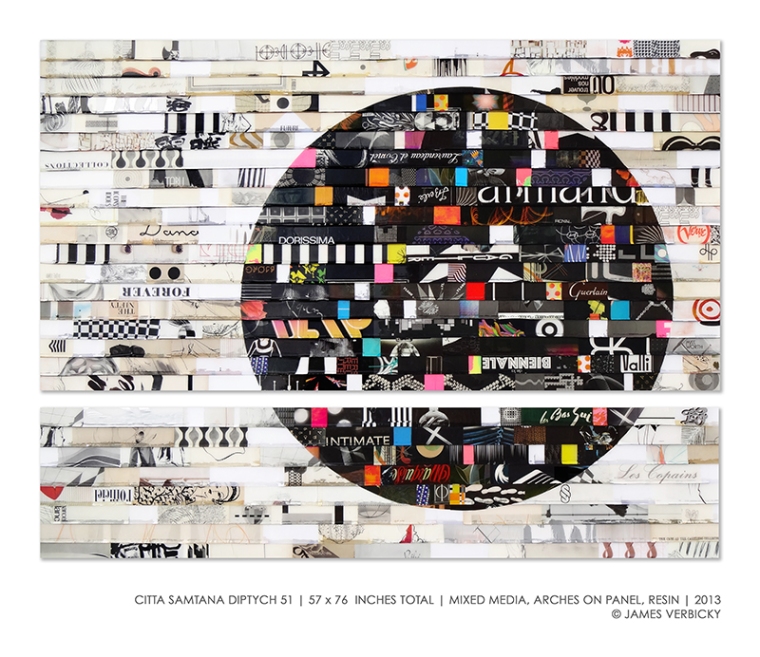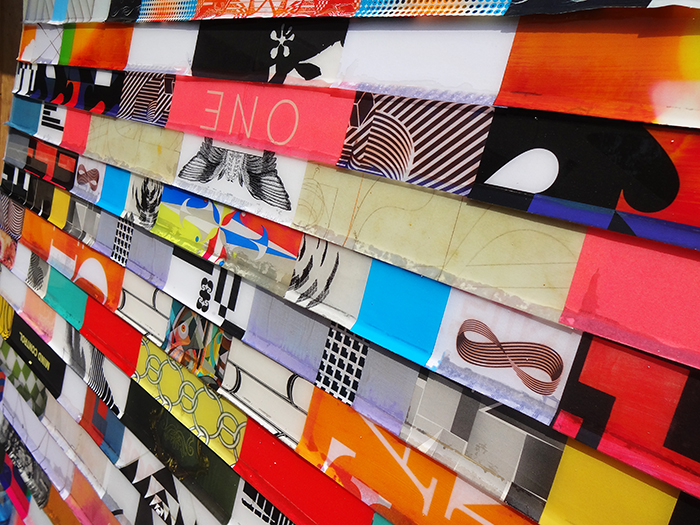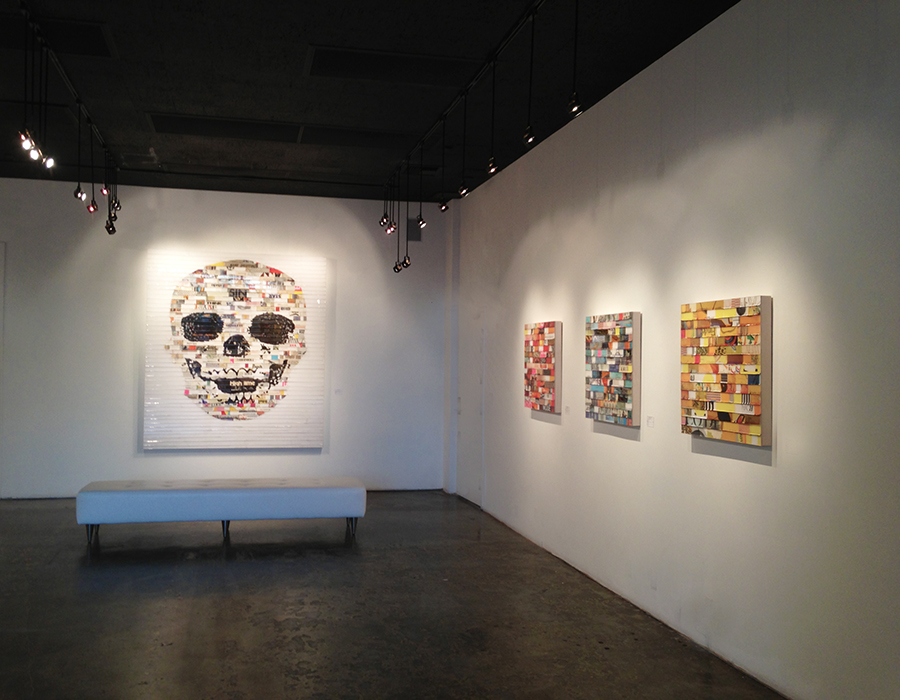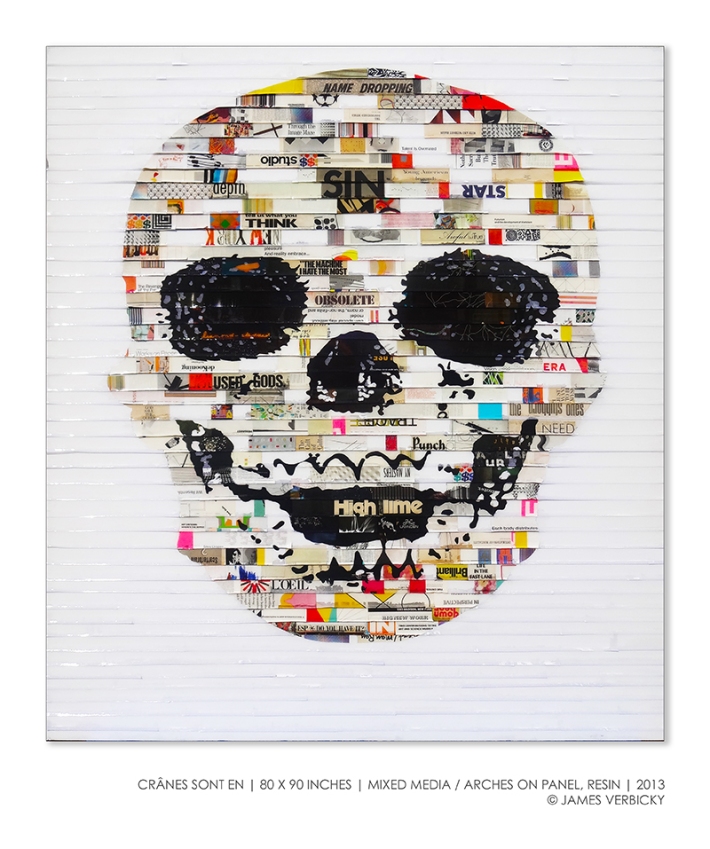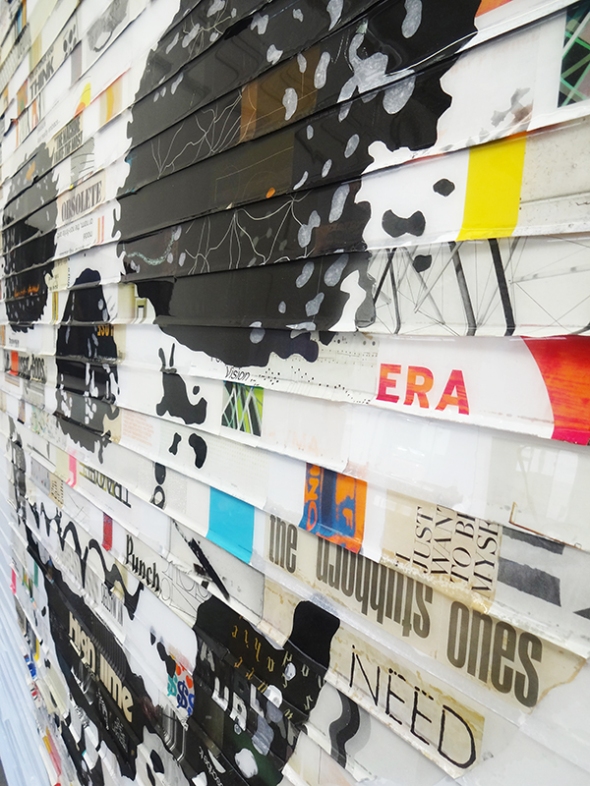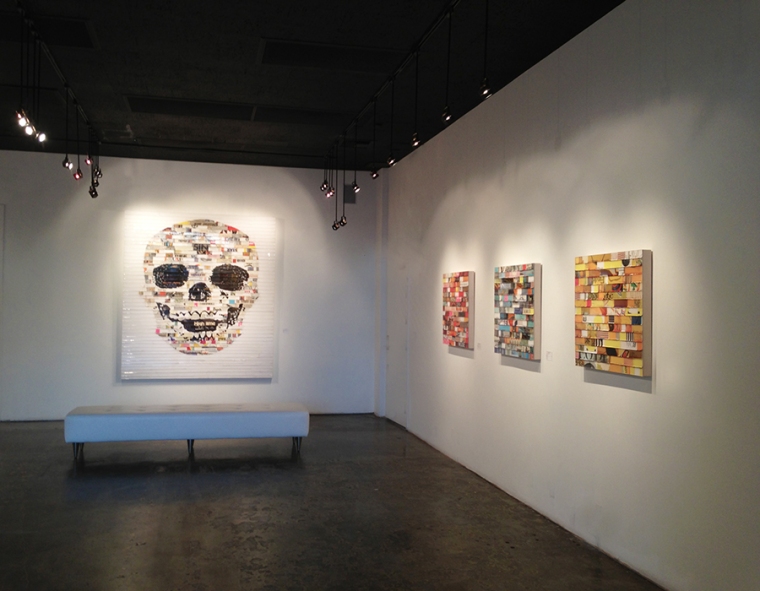MEDIA MARQUEE / By Bruce Helander
From a distance, James Verbicky’s new work conceivably could be misconstrued as a section of aluminum siding that has stood the test of time, depicting layers upon layers of advertising residue, perhaps halfheartedly scraped down to reveal fragmented bits and pieces of small but handsome communicative clues, like a modern day Rosetta stone, that still survive. As the viewer ventures closer, the origin of his materials becomes much clearer; the artist’s intentional iconology is swiped, borrowed and cut from the printed page. In some pieces, there is the visual ‘aroma’ of an unearthed quilted blanket or a nearly recognizable tattered post-war flag from a distant shore, a vintage venetian blind, or even a newsstand rack that once displayed publications with sell lines, headlines and cover girls. Observed from a theoretical distance in the sky, these engaging artworks can take on the appearance of other familiar scenes, such as rows of flowers in a large nursery, a four star general’s “fruit salad” of pinned ribbon awards, a translucent 35mm color slide rack, a racetrack blurred in action, or even the blitz of a CNN scrolling marquee at the bottom of a television screen, with the illustrated stock report flowing rightward until it disappears. In these “moving” pictures, Verbicky seems to become a de facto film director, fashioning a cinematic jump cut from assorted scenes and then sprinkling them onto his panel surfaces to form an uneven pattern that clings magnetically to the edge like the sidewalk remnants of a tickertape parade. He first sets up a horizontal grid of evenly spaced stripes, which has a comfort zone of familiarity because of pioneering contemporary artists like Kenneth Noland, Morris Louis and Piet Mondrian (or even a Jasper Johns flag), whose linear minimal works in the early sixties opened many doors for artists to come. Another young painter that comes to mind is William Finlayson, who creates works with parallel bands of alternating color. As we begin to connect the layered dots, which have been harvested from magazine headlines, advertisements, billboard scraps with colorful Ben-Day patterns, polka dot wrapping paper, vintage poster fragments, photographic images, typefaces of all varieties, foreign lettering, wallpaper, reproductions of other works (art about art), and a seemingly unending array of UFOs (unidentified fragmented overlays), we see what has made this artist’s work so engaging, recognizable and singularly unique.
Verbicky starts each piece with a perfectionist’s craftsmanship, utilizing high-end Baltic birch wood, which serves as a solid base for his built-up, aggressively textured surfaces that are neatly custom fitted into three dimensional gutters that eventually collect a menagerie of transparent paper material, as if they were precious patches of rainwater reflecting a rainbow from an unexpected downpour. Next, he begins the complicated formula that allows him a natural foundation for securing his overall collage-like patterns that are built, level by level, like a modern condo’s balconies where hints of human occupation are evident, such as a beach towel here, an umbrella there, and next to a lounge chair as an accent. Verbicky labels these as “Media Paintings,” as the materials utilized are nearly all cut out from magazines with a heavy dose of text and script and recognizable brand names. His work also is sculptural in nature, combining two-dimensional and three-dimensional planes, which technically fall into the category of relief sculpture or assemblage. The collaged paintings can be read either left to right or vice versa, initiating a back and forth motion that offers a constant momentum of visual activity and adds an extra dimension to his unusual compositions.
Putting bits of cut or torn paper together is a time-honored tradition, and actually evolved from Cubism, a process that broke down traditional narrative paintings into abstracted facets that still retained recognizable elements. Often these early experiments would incorporate the appearance of wood grain, wallpapers, fabrics and newspapers. The word “collage” originated from the French word “coller,” meaning to paste. Braque and Picasso were the first to incorporate paper into their paintings, which was a revolutionary idea that stirred up much controversy within the art community. Later, artists such as Kurt Schwitters, Max Ernst and Marcelle Duchamp utilized this new method, which continues to be respected and popular to this day. The most famous contemporary artist who utilized collage exclusively is Jacques de la Villeglé, who invented the term “décollage” (literally, “unpasting”), and for over forty years has been pulling down and salvaging the posters that adorn Parisian walls. Like Verbicky, Villeglé is satisfied with fragments and the whole repertoire of rips, scratches, scrawls and graffiti, which become impromptu novel devices that both artists characteristically incorporate into their work. The renowned contemporary collage artists Romare Bearden and Jess, who are unfortunately no longer with us, would be pleased to know that the value of their narrative collaged paper works has increased dramatically at auction and have become popular subjects for major museum surveys.
Recycling materials from the street or from used publications that no one wants are key elements that strengthen Verbicky’s sharp eye and artistic convictions, turning one man’s trash into another’s treasure. As a collage artist myself, this writer has a special appreciation and admiration for the minimal compositions reviewed here, because they require an exceptional knack for spatial relationships. It remains a distinct challenge and takes an understanding of abstraction to successfully reinvent printed materials that originally existed in another form. A late great colleague of mine, Ray Johnson, who specialized in collage and was famous for his bunny heads and his literally traveling show of correspondence art, often used simple black and white Xeroxed copy paper in his work. John Chamberlain, the celebrated artist who recently had a retrospective at the Guggenheim Museum, had a similar task when in the late 1950s he decided to make three-dimensional “collages” out of twisted and abandoned automobile parts. The Los Angeles-based collage artist Tony Berlant has spent his entire career making collages out of printed tin trays and advertising signs that are cut and “glued” down with hammered steel brads. So there is a historical fraternity of artists like Verbicky, who offer us a fresh vision and original insights that obviously can stand the test of time.
The simple point of all these disparate examples of artists working in the media of collage is that first, legendary and celebrated artists have brought collage into the forefront of respectability and invention and that this discipline continues to be an inventive tool for younger contemporary artists. Secondly, that there are special conceptual and perceptive skills that not many artists master, as it requires, unlike a traditional landscape or still life for example, an instinctual comfort zone in abstraction that can’t really be taught, but must be brought out intuitively, piece by piece, and mastered with practice and a natural sense of design, which Verbicky’s new series clearly demonstrates.
VIEW COLLECTION OF AVAILABLE WORKS AT DTR MODERN GALLERIES
NEW YORK CITY | BOSTON, MA | PALM BEACH, FL | WASHINGTON, D.C.
www.dtrmodern.com
BRUCE HELANDER – Author
Bruce Helander is the Editor-in-Chief of The Art Economist, the recently launched publication that examines the contemporary art market. He has a master’s degree in painting from the Rhode Island School of Design, where he later became Provost and Vice President for Academic Affairs. He is a former White House Fellow of the National Endowment for the Arts and has been awarded several grants from the New York Foundation for the Arts. As an artist, his work is in over fifty museum collections, including the Solomon R. Guggenheim Museum, the Whitney Museum of American Art and the Metropolitan Museum of Art. A work of his was included in the recent Sotheby’s auction of the estate of actor Dennis Hopper. He has been a contributor to numerous magazines, including Art and Living, ARTnews and The New Yorker. His latest book, Learning to See—An Artist’s View On Contemporary Artists From Artschwager to Zakanitch, was an Indie Awards Finalist.
• http://www.huffingtonpost.com/news/bruce-helander• http://www.brucehelander.com/

